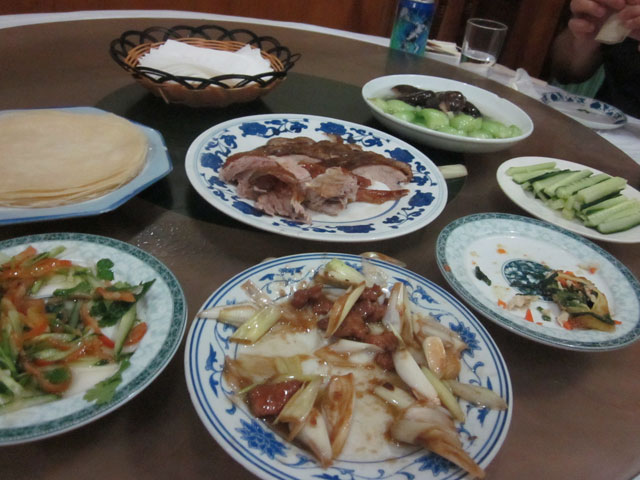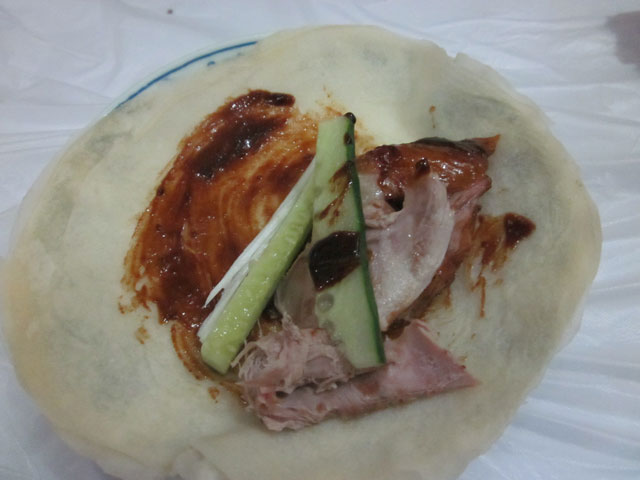 Even for budget travelers like ourselves, you can’t go toBeijing without tasting a little of the local specialty: Peking duck. A good restaurant can set you back several hundred kuai (a small fortune to us) but it’s totally worth it.
Even for budget travelers like ourselves, you can’t go toBeijing without tasting a little of the local specialty: Peking duck. A good restaurant can set you back several hundred kuai (a small fortune to us) but it’s totally worth it.
Our favorite duck restaurant is called Liqun, a small restaurant tucked into a hutong, (Beijings ancient alleys) near Tiananmen Square. The restaurant is small and grotty. You won’t find a grand dining room, with new linens on the table. You won’t hear traditional Chinese music playing or have a host of waiters at your beck and call waiting to serve you. What you get is a small, grimy, fast-paced restaurant with tasty, tasty food.
They have set menus based on the number of people in your party, and we got the 3-4 person menu with mostly vegetable side dishes. (The only other option we had was all meat side dishes including ducks feet, livers, tongues and other gross things I’m not into eating.) Our side dishes included spring rolls, Mongolian beef with onions, bok choy and mushrooms, mixed greens with a vinegar sauce and lotus root with jam in the middle. The three of us polished off almost every single plate.
Peking duck has a long and valued history. It was originally cooked for emperors and the royal court, but made its way into the streets for the common man to enjoy. Peking duck is more than just a roasted duck. There is a strict protocol to follow. First off the ducks, which are called White Beijing Ducks, are raised in a free range environment for 45 days then basically stuffed with food for the next 20 days where they bulk up. Then the ducks are killed, plucked, rinsed with water and pumped with air to separate the skin from the fat (somehow that makes it more delicious, though I’m not sure how.) The duck is then set on a hook to dry (sometimes it is dunked in salt water prior to hanging), covered in a sweet, molasses type sauce, and within 24 hours it is thrown in the oven and served.
There are two types of ovens typically used for Peking duck. One is an open brick oven in which the ducks are hung from hooks and certain woods, like cherry or peach tree wood is burned to give it a more delicious flavor. The other way to cook it is by roasting it in a closed oven, just like a chicken or turkey. Both are considered traditional styles, yet the open hanging ovens look way cooler. The duck ends up browned and beautiful, with a crispy skin, the insides nice and moist.
Then comes the slicing, and the eating, both of which are art forms. Each duck needs to be sliced into 120 pieces, and all pieces need to be of equal width and size, requiring some skill of the chef. Then before eating, it is best to watch others or get advice from an employee because it has a protocol too and includes several elements: pancakes, hoison type sauce, spring onions and cucumbers.
First you take a pancake (Peking duck is always eaten in a pancake) and pick up a piece of duck with your chopstick. Dip the duck into the sauce and use it as a paintbrush to put a layer of sauce around the whole pancake. Then, add a few more pieces of duck (not too much, they are small pancakes). Then add 2 pieces of spring onion, one slice of cucumber, then roll a little, turn up the bottom of the pancake (like a burrito) and then finish rolling it up. Voila!
There are basically internet wars over “The Best Peking Duck in China†with a few clear winners. If you are part of the Lonely Planet crowd, or like a little more authentic, adventurous restaurants, then Liqun is your best bet (I’m not saying it is more authentic than other places, it just feels more authentic. Plus, Anthony Bourdain came here on his show.) If you like clean bathrooms, crisp linens and a fancier feel, head on over to Quanjude or Dadong. I think all the ducks are equal in quality, you just get different side dishes and decor.
It doesn’t matter where you go, what matters is the you do go. So if you come to Beijing anytime do yourself a favor and find out why Peking Duck is famous the world round.






Leave a Reply